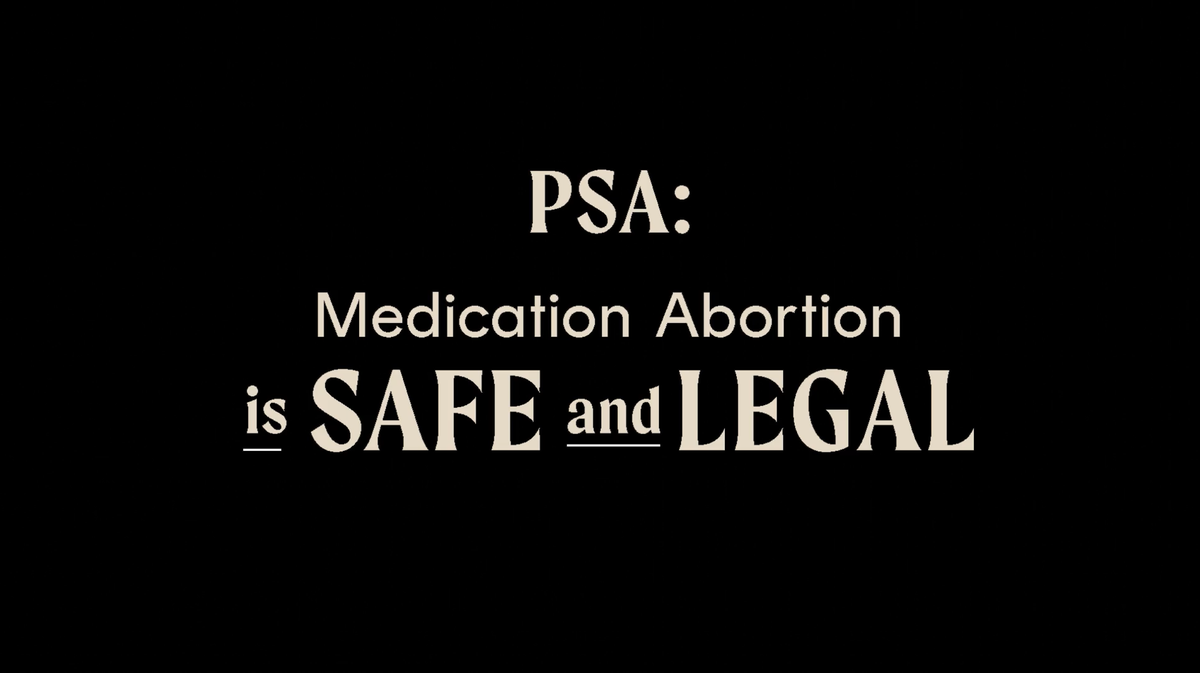Update: January 20, 2025
The past few years in reproductive rights have been...grim. To date, 17 states have banned or seriously restricted abortion since the Supreme Court overturned Roe v. Wade in 2022. (Six of these state bans offer no exception for the health of the mother.) What has this meant for abortion access? A lot of unnecessary suffering.
Just this year, risk-averse doctors have turned away women bleeding out from miscarriages or in sepsis. Since Roe was overturned, at least four women have died—and many more have had major health complications—because they could not get the care they needed.
Then on November 5, 2024, Donald Trump was elected president—again. His party’s draconian platform, Project 2025, aims to make medication abortions illegal. (This is how 63 percent of abortions in the U.S. happen.) Hospitals could deny lifesaving abortions to seriously ill pregnant people. People who ship or transport abortion pills could be prosecuted. Providers and people who want to terminate pregnancies could face surveillance, prosecution, and lawsuits. Even birth control and reproductive health care could be restricted.
That said, as of November 2024, abortion is still legal in most states. We can’t know what will happen during Trump’s second presidency but—for now—here is how to get a safe, legal abortion.
This story has been reviewed by Rathika Nimalendran, MD, a family medicine practitioner and abortion provider based in North Carolina.
News flash: Safe, legal abortion is still happening in the U.S. The Supreme Court’s June overturn of Roe v. Wade was devastating, but fortunately, the move was not a national abortion shutdown. While 12 states are now enforcing bans, 9 states actually expanded abortion access in 2022, and that doesn’t include 11 additional states with untouched abortion protections on the books.
All that to say, the abortion experience in the U.S. depends to a large extent on where you live. You might be based in a city where a clinic is walking distance away. Or you might be in a ban state that forces people to jump through lots of logistical hoops just to obtain what should be routine care.
No matter what your situation is, here are some steps you can take to get a safe abortion, including protecting your privacy, finding a provider, securing financial support for medical and travel costs, and learning about safe abortion methods so you feel informed and ready going in.
Find a Provider | Estimate Your Costs | Safe Abortion Methods for Every Stage of Pregnancy | Seek Support
The national climate is pretty fraught at the moment, so it pays to keep tabs on your internet footprint when making your abortion plans—because the last thing you need is for your search history or private health data to end up in the hands of trolls. Cosmo’s post-Roe guide to digital privacy includes crucial intel on safer internet searching, period-tracking apps, online messaging, and more.
For a host of reasons, most ob-gyns practicing in the U.S. don’t perform terminations. And with increasing abortion restrictions, doctors in certain states aren’t even allowed to talk to you about your medical options (some may even report patients for seeking care). So unless you already have a doc you trust, it’s best to go ahead and look specifically for an abortion provider, so there’s no question as to where they stand.
• For in-person procedures: Start with AbortionFinder.org or ProChoice.org. You can also call the National Abortion Federation (the folks behind ProChoice.org) at 877-257-0012 or Planned Parenthood at 800-230-PLAN.
• For abortion pills to take at home: Go to PlanCPills.org, where you can search for a telehealth provider that operates in your state. The big ones include AidAccess, Hey Jane, Just the Pill, Carafem, and Choix. Here, you can also find updated info on legal considerations for accessing abortion pills where you live. Even if your state has restrictions on abortion pills or telehealth, access may still be possible—but could come with legal risks. The reproductive rights nonprofit If/When/How runs a helpline at 844-868-2812 (and the ReproLegal Helpline website) that can help you find answers to legal Qs.
Important warning: As you search for a provider, beware of anti-abortion organizations posing as abortion clinics, most commonly billed as “crisis pregnancy centers.” These facilities will often offer free ultrasounds to get pregnant people in the door, then actively try to dissuade those people from getting abortions. Crisis pregnancy centers do not perform abortions. When in doubt, ask during your very first contact with a facility—you don’t want to waste precious days talking to someone who doesn’t offer the care you need.
Time is of the essence in our post-Roe landscape. In the states where abortion remains legal, wait times for in-person appointments are getting longer. Plus, in some states—even for abortion procedures that are simple and take only minutes—patients are required to schedule two appointments: one for mandatory counseling and another, up to three days later, for the procedure itself. As 6-week abortion bans and other restrictions become more common, each day is critical to obtaining the care you need.
Pretty much every kind of health care in the U.S. is expensive, but for many patients, abortion often comes with expenses beyond the procedure itself, including long-distance transportation, childcare, a hotel stay, and/or unpaid leave from work. Local and national resources may be able to help cover costs if you need an assist.
• If you have insurance: Find out what your plan covers (if anything). While some plans include abortion coverage, at least 10 states ban private insurers from covering abortion care except for rare instances when the pregnant person’s life at risk. Seventeen other states ban abortion coverage for certain types of plans. (Note for future you: Next time open enrollment comes around, you might be able to buy a “rider” that covers abortion. Ask the insurance provider before you sign up.)
• If you don’t have insurance: Ask the clinic about payment options when you call for a consultation. Many offer information about local funding options, including abortion funds. Some clinics accept credit cards as well.
• Find out whether your employer will pay for travel. In response to the new spate of abortion bans in the U.S., a growing number of major companies (including Amazon, CitiGroup, Uber, Target, and Yelp) are now offering assistance to employees who have to travel out of state for abortion care.
If you’re still struggling to cover abortion costs, these national organizations may be able to help.
• National Network of Abortion Funds (NNAF): NNAF is the first place to contact if you need an abortion but don’t think you can afford one. Based on location, the group can help you figure out whether Medicaid can cover the cost of a procedure and/or whether you’re eligible to access a local, state-based abortion fund for monetary support.
• National Abortion Federation (NAF): The NAF Hotline can offer information on clinics offering quality care—a constantly changing landscape right now—and what the best option might be for you. Depending on your level of need, NAF may be able to assist with medical funding as well as travel arrangements, especially if your pregnancy is further along.
• Women’s Reproductive Rights Assistance Project (WRRAP): Located in California, WRRAP is another national funding source if you aren’t sure you can afford a procedure. WRRAP only provides funding to clinics that are in their approved network, so be sure to ask if the clinic you schedule with works with WRRAP. If it does, the clinic will help you figure out how to proceed.
There are several different ways to have a safe abortion. Providers usually base their recommendations on how far along a person’s pregnancy is. Your provider may advise another approach based on your personal circumstances. Here are the safe abortion methods to know about at every stage of pregnancy.
Many people refer to it as the abortion pill, but this method actually includes two sets of pills: The first pill, mifepristone, is often taken at the clinic depending on which state you live in. Mifepristone blocks the hormone progesterone, which then causes your uterine lining to break down (like before your period). The second set of pills, called misoprostol, causes your cervix to soften and dilate and your uterus to contract, which expels the pregnancy. If you’re 9 weeks or less, you can take the misoprostol by mouth or vaginally right after you take the mifepristone. If you’re more than 9 weeks, you’ll need to wait 24 to 48 hours after you take the mifepristone.
What to Expect
After you take the mifepristone, you may experience no symptoms at all or mild nausea. Things really start happening after you take the misoprostol. Be prepared for cramping and bleeding (like a really heavy period) that can last four to six hours after you take the pills. Your provider can give you personalized advice for managing the pain. You might notice blood clots or grayish-white clumps of pregnancy tissue, says Pratima Gupta, MD, a fellow at Physicians for Reproductive Health.
Wait a week before putting anything into your vagina (a tampon, a penis, even bath water—although it is safe to shower) in order to reduce the risk of infection. You’ll have spotting, so stock up on pads. Your clinic will provide you with a follow-up plan as well, which may include a home pregnancy test, a nurse phone call, a blood test, and/or an ultrasound to make sure you’re not pregnant anymore. On average, medication abortion is 97 percent effective on the first try. In rare cases when it isn’t, providers may recommend taking a second dose of misoprostol, which is 99 percent effective. If that doesn’t work, which is very rare, you may need a vacuum aspiration.
What It Costs
$400 to $800 out of pocket.
The most common in-clinic abortion procedure, vacuum aspiration (also called a D&C—dilation and curettage), involves stretching the opening of the cervix and emptying the uterus with a suction device. On a case-by-case basis, the provider may do a sweep with a curette to ensure all the pregnancy tissue is removed. The provider may also prescribe antibiotics. Although it will take your doctor a while to get you and everything else set up, the procedure itself takes only 5 to 10 minutes. Many people prefer this method to pills because you can walk out and be D-O-N-E.
What to Expect
Pain medication is standard, and providers may offer some form of sedation—ranging from numbing at the cervix to an IV drip to (rarely) general anesthesia. Then the doctor dilates the cervix with medication or a series of progressively larger instruments that push it open. Throughout the procedure, you’ll feel pressure. Some women feel painful cramping; others don’t. Still, “there shouldn’t be extreme pain,” says Jennifer Conti, MD. Afterward, if you were sedated, you will feel groggy for a few hours and need someone to drive you home. You may also have spotting for up to 14 days that necessitates wearing pads, Dr. Conti says. Your doctor may request a follow-up in two to four weeks to make sure you’re back to 100 percent.
What It Costs
$400 to $1,500 out of pocket in the first trimester. The procedure could cost more if your pregnancy is further along or if you opt for IV sedation.
A D&E is similar to an aspiration, but because the pregnancy is further along, the cervix must be softened and stretched a few hours or the day beforehand. When performed before 15 weeks, a D&E is a one-day procedure. After that, you can probably count on a two-day process. The procedure itself takes 10 to 30 minutes.
What to Expect
To open the cervix, your provider will give you misoprostol or insert one or more thin rods (such as laminiaria, made from medical-grade seaweed) into your cervix, where they gradually expand. It can be uncomfortable, so you’ll get pain meds, or possibly something stronger, plus antibiotics. Dr. Nimalendren says many D&Es are done in freestanding clinic procedure rooms under IV sedation. Others are done in an operating room with IV or general anesthesia. You may be offered a shot in the abdomen to stop the fetal heartbeat, and then your doctor will remove the pregnancy tissue in portions with medical instruments such as forceps. As with aspiration, recovery will include some bleeding and cramping for a few days.
What It Costs
$800 and up out of pocket. In general, the further a pregnancy has progressed, the higher the fees.
Accounting for just a few thousand abortions in the U.S. every year, this later-pregnancy procedure generally involves delivering the fetus vaginally at a hospital or specialized clinic. Patients “go through a process similar to labor, with the cervix opening and possibly pushing to deliver the pregnancy,” Dr. Gupta explains. It’s sometimes offered to patients who are less than 20 weeks along too, in cases where patients wish to hold the fetus after delivery or request an autopsy to better understand abnormalities that may have made a pregnancy nonviable.
What to Expect
Your provider will offer you an optional shot in your belly to stop the fetal heart. Then the provider will use medications to soften the cervix—which could took take a day or two—and induce contractions. Your water will break and you’ll feel cramping and pain. “You have the option of an epidural,” Dr. Conti adds. The process can take several hours or several days. Barring a medical issue, you can go home a few hours after the fetus is out. Recovery can take longer than after other types of abortions and may include vaginal swelling, soreness, spotting, and potentially lactating.
What It Costs
$5,000 and up out of pocket. Cost and insurance coverage varies widely.
Ending a pregnancy can be challenging in multiple ways—logistically, emotionally, socially, and financially. But follow-up research shows that by three years later, 99 percent of women seeking abortions feel they made the right choice. If you’re able to, confide in someone you trust. “It can be really helpful to have the support of at least one person,” says Rathika Nimalendran, MD, a family medicine practitioner and abortion provider based in North Carolina. Also good to know about: The after-abortion support group Exhale offers a confidential textline at 617-749-2948 and can offer leads on local support groups.
Additional reporting by Robin Marty and Caitlin Moscatello.




















